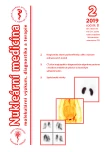-
Medical journals
- Career
CT pulmonary angiography as a part of a diagnostic algorithm in a patient with a recurrent pulmonary embolism and a chronic renal failure
Authors: Otto Lang 1,2,3; Ivana Kuníková 1
Authors‘ workplace: Klinika nukleární medicíny, 3. LF UK a FNKV, Praha 10 1; Oddělení nukleární medicíny, Oblastní nemocnice Příbram, a. s. 2; Oddělení nukleární medicíny, PMCD s. r. o., Praha 6, ČR 3
Published in: NuklMed 2019;8:29-33
Category: Casuistry
Overview
Introduction: The aim of our case report is to demonstrate overuse and potentially risky use of pulmonary CT angiography in patient with a recurrent pulmonary embolism and a chronic renal failure.
Material and methods: 56-y-old patient was sent to our department by his general practitioner to an emergency follow-up lung perfusion scintigraphy due to an exertional dyspnea which appeared after termination of anticoagulant therapy in April 2010. He had a bilateral pulmonary embolism on March 2008 with a massive recurrence in September 2008 also after termination of anticoagulation in his history. Recent pulmonary scintigraphy demonstrated again bilateral segmental to lobar embolism and the patient was sent to hospitalization to the internal department.
Results: Emergency CT pulmonary angiography was required immediately after the admission. It demonstrated emboli with a partial flow around in the lobar arteries for the upper and the lower lobe of the right lung and for the lower lobe of the left lung in accordance with pulmonary scintigraphy. The patient has a chronic hydronephrosis with afunction of the right kidney with a chronic renal failure in his history. Ultrasonography did not detect any thrombosis in the lower extremities veins, hematological investigation revealed only slight factor IX deficit, echocardiography was normal, oncological screening was negative. Patient was discharged after LMWH treatment, follow-up study was not required.
Conclusion: CT pulmonary angiography did not bring any new information comparing to lung perfusion scintigraphy. Moreover, the patient had a functionally solitary kidney with a chronic renal insufficiency. Therefore, we believe that the CT pulmonary angiography was redundant and potentially dangerous for the patient. We also believe, that the follow-up study after pulmonary embolism is important from the point of view of possible progression to CTEPH and should be required.
Keywords:
pulmonary embolism (PE) – CT pulmonary angiography (CTPA) – scintigraphy – chronic renal insuficiency
Sources
- Nikolaou K, Thieme S, Sommer W, et al. Diagnosing Pulmonary Embolism.New Computed Tomography Applications. J Thorac Imaging 2010;25 : 151–160
- Widimský J, Malý J, a kol. Akutní plicní embolie a žilní trombóza. Praha - 3. vydání, Triton, 2011, Praha, 420 p
- Leblanc M, Paul N. V/Q SPECT and Computed Tomographic Pulmonary Angiography. Semin Nucl Med 2010rok?;40 : 426-441
- Miniati M, Monti S. Should lung scan be abandoned for pulmonary embolism diagnosis in the age of multislice spiral CT? No. Intern Emerg Med 2009;4 : 193–194
- Lang O, Kuníková I. Změna kolektivní efektivní dávky pacientů vyšetřovaných pro podezření na embolii do plicnice po zavedení víceřadého CT – zkušenost jednoho pracoviště. NuklMed 2016;5(S1):17(A)
- Reid JH, Coche EE, Inoue T, et al. Is the lung scan alive and well? Facts and controversies in defining the role of lung scintigraphy for the diagnosis of pulmonary embolism in the era of MDCT. Eur J Nucl Med Mol Imaging 2009;36 : 505–521
- Suga K, Yasuhiko K, Iwanaga H, et al. Relation between lung perfusion defects and intravascular clots in acute pulmonary thromboembolism: Assessment with breath-hold SPECT–CT pulmonary angiography fusion images. Eur J Radiol 2008;67 : 472–480
Labels
Nuclear medicine Radiodiagnostics Radiotherapy
Article was published inNuclear Medicine

2019 Issue 2-
All articles in this issue
- Detection of an acute pyelonephritis in children – a value of imaging methods
- CT pulmonary angiography as a part of a diagnostic algorithm in a patient with a recurrent pulmonary embolism and a chronic renal failure
- Ascites detected on a whole-body bone scan
- Ventilačně-perfUzní scintigrafie plic stanovisko Výboru ČSN M k provádění vyšetření
- Nuclear Medicine
- Journal archive
- Current issue
- Online only
- About the journal
Most read in this issue- CT pulmonary angiography as a part of a diagnostic algorithm in a patient with a recurrent pulmonary embolism and a chronic renal failure
- Detection of an acute pyelonephritis in children – a value of imaging methods
- Ascites detected on a whole-body bone scan
- Ventilačně-perfUzní scintigrafie plic stanovisko Výboru ČSN M k provádění vyšetření
Login#ADS_BOTTOM_SCRIPTS#Forgotten passwordEnter the email address that you registered with. We will send you instructions on how to set a new password.
- Career

